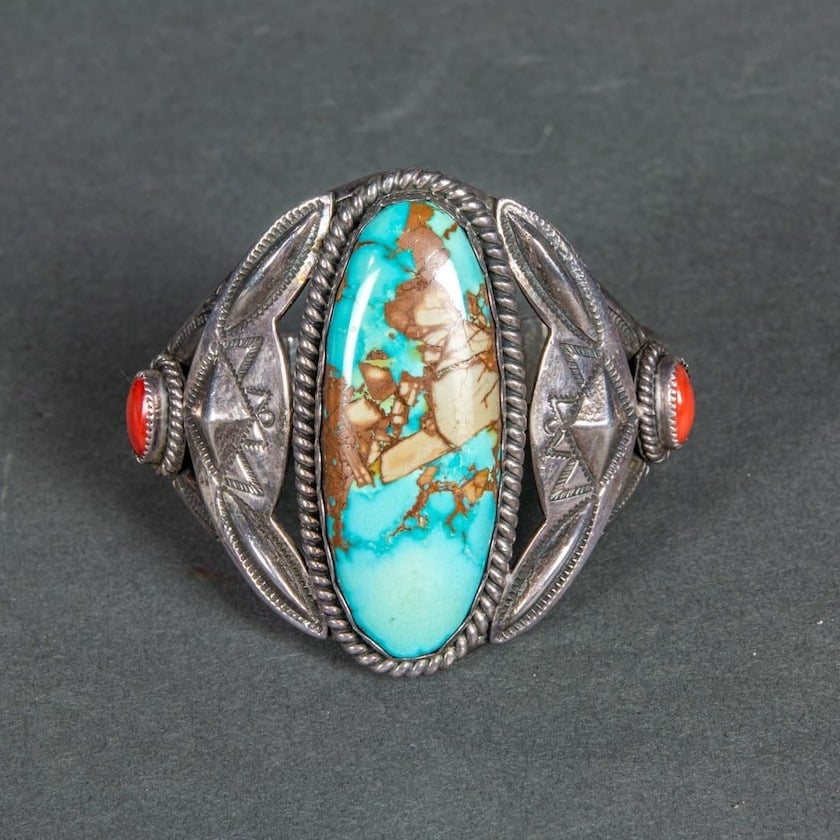Jewelry Silver Content
For jewelry use, silver is often mixed with other metals. Learn how silver content varies between alloys and how to test an item’s silver purity.
2 Minute Read
Silver as a Jewelry Metal
Silver has always played somewhat of a second fiddle to gold as a precious metal. Still, the bright, white metal has had its moments, from William Jennings Bryan's "Cross of Gold" peroration to the Hunt brothers' effort to corner the silver market in 1980. As gold advanced in price at the end of 1979 and into 1980, a greater interest in silver as a jewelry metal developed, not only as a primary metal but also as a component of vermeil, a term for a gold-plated or gold-filled silver.
That silver would increase in value along with gold isn't too surprising. This most attractive of white metals has enjoyed its role as a favorite almost as long as its yellow companion. Like gold, silver is a malleable metal, capable of being hammered without crumbling. Its softness — a disadvantage for the most part in securing gems — makes it easy to fashion.
Interested in this topic?
This article is also a part of our Turquoise Specialist Mini Course, in the unit How to Choose a Turquoise.
Silver Content, Alloys, and Marks
Here's a list of the various compositions of silver alloys and their marks.
| Mark | Alloy % | Fine Silver % |
| .999 | Fine or pure | 99.9 |
| Hallmark | 4.16 | 95.8 |
| Sterling | 7.5% copper | 92.5 |
| Coin | 10% copper | 90.0 |
Anything with a fine silver content lower than 90% ranks as low-quality silver. Much of this low-quality silver is produced for the tourist market in Europe, India, Mexico, and the Orient. The fine silver content of this material runs anywhere from 50% up to 80%.
This sterling silver jewelry set includes clip-on earrings and a bezel-set amethyst cuff bracelet. The earrings are marked "Mex 925," which indicates they're 92.5% fine silver. The bracelet bears the maker's mark as well as the "Sterling" stamp. Photos courtesy of liveauctioneers.com and Austin Auction Gallery.
Testing Silver
Generally, you can trust the "Sterling" stamp on an item. Most silver metal buyers do, unless something obviously appears amiss.
Testing silver isn't much more difficult than testing gold.
Nitric acid reacts very quickly with silver. To determine if an item is silver-plated or solid silver, file an inconspicuous slot in it and apply a drop of nitric acid. (NOTE: nitric acid can be very hazardous if used carelessly. Please familiarize yourself with safety procedures for handling this material and follow the instructions accompanying commercially available nitric acid).
If there's base metal underneath, the slot will show a green color while the silver plating around the file mark will be gray. Should the item be solid, both the slot and the area around it will be gray.
Only silver does this. No other white metal reacts to nitric acid in this manner. The alloy known as German silver or nickel silver (which contains nickel, zinc, and other metals) will turn green.
Stainless steel, platinum, and white gold will have no reaction to the acid.
Generally speaking, you'll find silver-plated items in silverware. Inexpensive jewelry items are also usually silver-plated. (Sometimes, they'll have a rhodium-colored epoxy dip applied over a base metal).
Silver Content in Dinnerware
The silver-plated dinnerware made in the United States is customarily marked "plate" or "plated," together with the maker's brand name and a signature indication. These days, if silverware or dinnerware doesn't have a "Sterling" mark, you almost certainly have plated merchandise.
Dr. Gerald Wykoff GG CSM
Dr. Gerald Wykoff is GG (Graduate Gemologist), a CSM (Certified Supreme Master gemcutter), educator, and author of several gemology books. He founded the American Society of Gemcutters in the 1980s and served for more than 10 years as the editor of its monthly magazine, American Gemcutter.
Related Articles
Mokume-Gane Metal Techniques
Milling Platinum Sterling (A New Alloy)
Testing Gold Karatage and Interpreting Marks
An Introduction to Precious Metal Clay Jewelry
Latest Articles
Classic Engagement Ring Stones
Broken Bangle — The Blunder-Besmirched History of Jade Nomenclature: Book Review
Cuprite Value, Price, and Jewelry Information
Gemstone Radiation Treatment
Never Stop Learning
When you join the IGS community, you get trusted diamond & gemstone information when you need it.
Get Gemology Insights
Get started with the International Gem Society’s free guide to gemstone identification. Join our weekly newsletter & get a free copy of the Gem ID Checklist!
